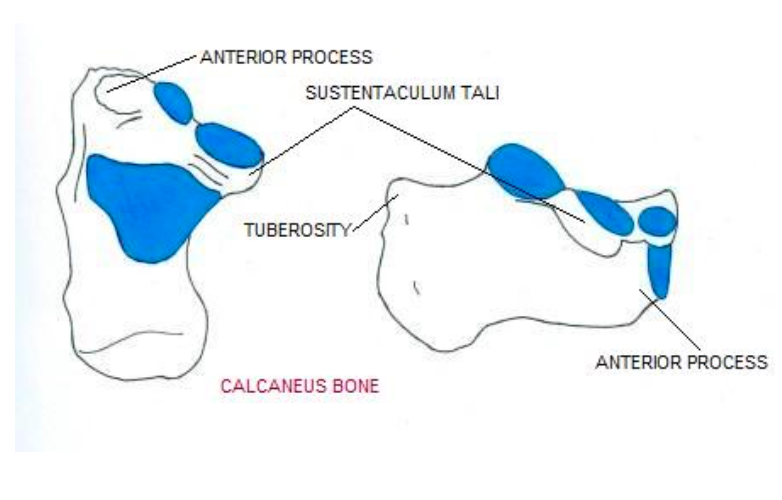
Foot and Ankle Bones (northcoastfootcare.com)
Definition: Fracture of the calcaneus bone
Mechanism
- Traumatic axial loading is the most common cause (eg fall from height)
- Can also occur in MVCs when the accelerator/brake pedal impacts the foot
- Stress fractures seen with overuse from repetitive impact (e.g. runners)
Epidemiology
- 2% of all fractures
- Most frequently fractured tarsal bone
- 90% occur in men between 21 and 45 years of age with majority being industrial workers
- Approximately 10% are open fractures (Egol 2010)

The Calcaneus (joint-pain-expert.net/calcaneus)

Ecchymosis after Calcaneus Fracture (orthopaedicsone.com)
Physical Exam
- Moderate to severe heel tenderness
- Swelling
- Shortened wide heel with varus deformity
- Ecchymosis around heel extending to arch is highly suggestive, may also see fracture blisters
- Compartment syndrome occurs in 10% of calcaneal fractures and can result in clawing of the toes after recovery (Egol 2010)
- Concomitant Achilles tendon rupture may be present
Calcaneus Fracture Classification (See Images in Gallery Below)
- Extra-articular (subtalar joint)
- 25% of all calcaneus fractures
- Avulsion injury of:
- Anterior process by bifurcate ligament
- Sustenaculum tali
- Calcaneal tuberosity (Achilles tendon avulsion)
 Intra-articular
Intra-articular
- 75% of calcaneus fractures
- 2 classification systems
- Essex-Lopresti Classification
- The primary fracture line runs obliquely through the posterior facet forming two fragments.
- The secondary fracture line runs in one of two planes:
- “Tongue-Type” Fracture
- Axial plane beneath the posterior facet exiting posteriorly
- This fracture tends to cause tension on the skin with possible necrosis. Consider an emergent orthopedics consult for all patients with this pattern (Snoap 2017)
- Behind the posterior facet in joint depression fractures
- “Tongue-Type” Fracture
- Sanders (based on CT)- based on number and location of articular fragments seen on the coronal CT image at the widest point of the posterior facet (E)
- Type I: all nondisplaced fractures
- Type II: two-part fractures of the posterior facet
- Type II: three-part fractures with centrally-depressed fragment
- Type IV: four-part articular fractures
- Essex-Lopresti Classification

Sanders Classification (foothyperbook.com)
Calcaneus Fracture Classification Images

Bohler Angle (orthobullets.com)
Diagnostic Imaging
- Standard X-rays: AP, lateral, oblique foot
- Optional X-rays (See Image Gallery below)
- Broden views: allows visualization of posterior facet
- Harris View: visualizes tuberosity fragment widening, shortening, and varus positioning
- AP ankle: demonstrates fibular impingement if lateral wall extrusion is present
- Findings in calcaneal fractures:
- Reduced Bohler angle
- Created with lines drawn tangiental to anterior and posterior aspects of superior calcaneus
- Normal is 20-40 degrees
- Increased angle of Gissane
- Formed by downward and upward slopes of calcaneus
- Normal is 95-105 degrees
- Non-contrast CT
- Obtain when clinical suspicion of a fracture is high despite negative x-rays
- Gold standard imaging test for any calcaneal fracture (except for stress fractures)
- Will almost always be obtained for pre-operative planning but does not necessarily need to be obtained in the ED

Angle of Gissane (orthobullets.com)
Associated Injuries
- Vertebral injuries secondary to axial loading injury (10%)
- Contralateral calcaneal injury (10%) (Hatch)
ED Management
- Provide analgesia
- Complete neurovascular exam
- Consider compartment syndrome
- Can initially be placed in Bulky Jones dressing with supportive posterior splint to provide flexion
- Conservative therapy (casting + nonweightbearing)
- Casting and nonweightbearing for 6 weeks for calcaneal stress fractures
- Casting and nonweightbearing for 10-12 weeks if:
- Small extra-articular fracture (<1 cm) with intact Achilles tendon and <2 mm displacement
- Sanders Type I (nondisplaced)
- Anterior process fracture involving <25% of calcaneocuboid joint
- Comorbidities that preclude good surgical outcome (smoker, diabetes, PVD)
- All other fractures require surgical intervention
Prognosis: Relatively poor with overall 40% complication rate (malunion, subtalar arthritis, clawing of toes)
Take Home Points
- Always suspect calcaneus fractures in patients with axial loading injuries to the lower extremities. If a calcaneus injury is found, look for concomitant fractures of the ankle and vertebrae.
- Patients with calcaneal fractures will always be nonweightbearing on ED discharge
- Watch out for compartment syndrome of the foot which occurs in 10% of calcaneal fractures and results in significant morbidity
Read More
Ortho Bullets: Calcaneus Fractures
References
- Barrie J. (2013) Calcaneal fractures. [East Lancashire Foot and Ankle Hyperbook]. Link
- Egol KA et al. Handbook of Fractures 4th ed. Lipincott 2010: 507-519.
- Gitajn IL et al. Anatomic alignment and integrity of the sustenaculum tali in intra-articular calcaneal fractures. J Bone Joint Surg Am. 2014; 96(12): 1000-1005. PMID: 24951735.
- Snoap T et al. Calcaneal Fractures: A Possible Musculoskeletal Emergency. J Emerg Med 2017.52 (1), 28-33 PMID: 27658550






